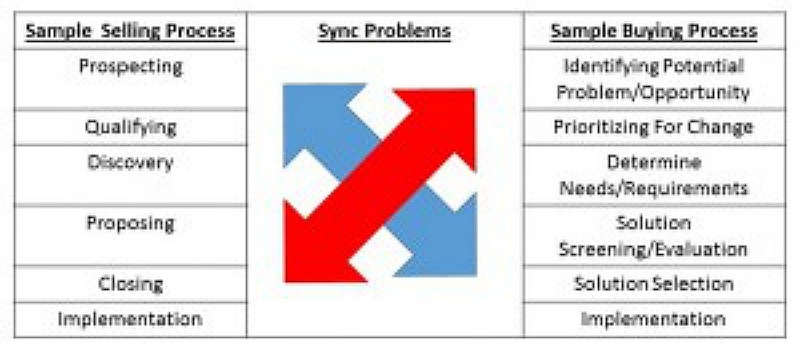
Are You Aligned With Where Your Customer Is In Their Buying Process?
A friend called me for advice today. He’s a great sales person, a big deal hunter. He wanted to review a deal strategy and call plan he was making on a CTO at a very large, fast growing prospect. His colleagues had been working with the CTO’s team. By far, they were the front runners for their first piece of business with this customer. By itself, it was a big order, but his colleagues saw a lot more potential in the account.
That’s why they got my friend, let’s call him “John,” involved.
Reviewing the account, their growth, their requirements, John saw the possibility of much more business. He was preparing his deal strategy and for his first call on the CTO. He viewed it as a “Discovery Call,” and was seeking to understand the key business drivers, getting the CTO’s vision, his perspective on the key issues the broader organization faced, as well as the ability of the IT organization to effectively support the rest of the business.

As I reviewed John’s deal and call plans, it was very good. Yeah, guys like me always have to find a reason to nit pick or get people to stretch a little, but John had done a good job in putting together the discovery call.
My “nitpicking” ended up being, “John, great plan–but it’s the wrong thing to do, forget discovery, ask for the order!” Over the phone, I could almost hear John falling off his chair. For years, I’d been drumming into him the importance of high quality discovery calls. John had mastered these and leveraged them to produce stunning results. He couldn’t believe I was telling him not to do it, and to go for the order.
As good as John’s plan was, it was totally inappropriate for where the customer was in their buying process. The work that John’s colleagues had done had gotten the customer to the purchase decision stage of their buying cycle. They had just about made the decision for John’s company, but John and his colleagues saw a far greater opportunity to help the customer, as well as greater revenue from the customer.
Had the team changed their approach, moving back into discovery, they would have been way out of step with the where the customer was in their process. Forcing the customer back into discovery mode could have adversely impacted the customer and their perception of John and his solution.
It’s critical we are aligned with the customer and where they are in their buying process. While our research is a little old, a number of years ago, we analyzed over 700 deals across a number of customers and suppliers. We found for every stage of misalignment between the buying and selling process, the probability of winning the business decreased by 10-20%. (See the figure below) In John’s case, he was about 2 stages behind the customer. As a result, his probability of winning would be significantly decreased.

Without going into the research, it’s easy to understand how this disconnect happens. Think of those calls you used to get around dinner time. It’s always someone wanting to you to buy something (usually switching telephone/cable plans) that you didn’t want to buy. The call would be an offer at some amazing price, with heavy attempts at closing from the salesperson. But we didn’t have a need to buy! So here the sales person was trying to close us on a problem/need we didn’t have. They were way out of sync with where we were in our buying processes, as a result, the success of those calls was very low.
Sometimes, it manifests itself in a different way. You probably know what I’m talking about. It’s the 57-70 (or 92%–depending on the survey you believe) of the way customers are through their buying process when they first contact sales. It’s that RFP that suddenly hits your desk, the one you know nothing about.
The customer has narrowed their needs, they are looking for a specific solution or a proposal. Yet we are several stages behind, we haven’t even qualified or done discovery on the opportunity. As a result, our probability of winning plummets. We are out of sync with where the customer is in their process (which is why I make the statement that I never respond to a RFP that I didn’t write.).
Sometimes, I liken this to being late to a party. You know, you’re hours late to a party, all the little conversation groups have formed, people are well involved in discussions about all sorts of things and you try to join–but you’ve missed all the early conversation, you have none of the context. You stand uncomfortably at the fringe of the group, listening, kind of getting it, but not quite, afraid to join in because you’ve missed so much of what’s gone on before.
Now here’s where it gets really complicated and confusing.
If we are to maximize our ability to win, we have to be in sync with the customer and where they are in their buying process. Clearly, we’re smart enough not to try to close the deal too fast (at least the regular readers of this blog–the people that should be reading—well that’s a different story).
But what happens when we are late? What happens when the customer has done their research, they’ve outlined their needs and requirements and want a response?
Are we supposed to skip all the stages of our selling process (i.e. Qualifying, Discover) and rush to a proposal?
Actually, it’s the wrong thing to do. Qualifying and discovery give us critical pieces of information, deep understanding of what the customer is trying to achieve, why, how they have gotten to where they are in their buying process. Without understanding this, our ability to be responsive, to create the maximum value and differentiation for our customers is seriously compromised.
Consequently, we have to go through our qualifying and discovery. We have to recognize the customer may become frustrated and impatient. They want to buy, they want to move on, we’re slowing them down. Great sensitivity is required, we have to help the customer understand why we are backtracking and slowing them down, but why it’s important to them that we do this.
In reality some customers may be too impatient and unwilling to do this. We may choose to disqualify and not compete in those circumstances. If we can get the customer to take the time, we have to move quickly, but we do have to do a complete job of discovery. Again, making sure they understand why we are doing this and the value they get from this is critical to our shared success.
Clearly, the best solution is to avoid being “late to the party.” Getting engaged early, making sure we are in sync with the customer–in fact helping to guide and facilitate their buying process. As much as we may want to accelerate our selling process, doing so puts us out of sync with the customer. The only way we accelerate our sales process, without compromising our ability to win, it to help the customer accelerate their buying process.
Some of you are reflecting back to my advice to John. You’re probably thinking, “Dave, you’ve really confused us. John was late to the party, but you said we still have to do qualifying and discovery. But you told John to go for the close. What’s up?”
John’s situation is a little different (as everyone’s situation is–that’s why we have to pay attention). John’s team had been engaged with the customer through their buying process. They had reached the closing point, when they realized there was a far greater opportunity, bringing John into the situation. In this case, it would have been inappropriate to backtrack for the bigger deal. What John ended up doing is accepting the order and initiating a conversation about the next thing his company and the customer might do to improve their performance.
If we are to maximize both our customer and our success, we always have to align our selling process with where the customer is in their buying process. The easiest way to do this is to start with them at the beginning, working with them through the cycle.
Do you have a sales process and playbooks that help align with the customer's buying process? Find out how it works in Membrain.

By Dave Brock
Dave has spent his career developing high performance organizations. He worked in sales, marketing, and executive management capacities with IBM, Tektronix and Keithley Instruments. His consulting clients include companies in the semiconductor, aerospace, electronics, consumer products, computer, telecommunications, retailing, internet, software, professional and financial services industries.
Find out more about Dave Brock on LinkedIn








